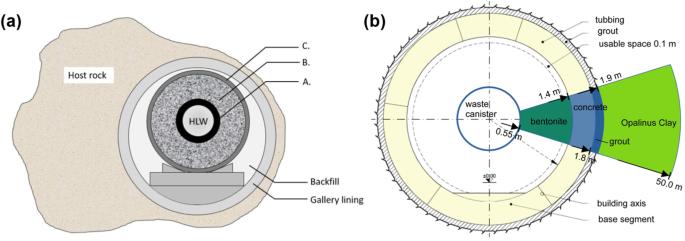The essential role of cement-based materials in a radioactive waste repository
引用次数: 0
Abstract
Cement-based materials are integral to radioactive waste repositories, providing versatile solutions for diverse disposal strategies. They are part of the multi-barrier system, and serve to immobilize waste materials, limit the release of radionuclides, contribute to an alkaline near-field to inhibit steel corrosion, reduce microbial activity, and slow down radionuclide transport in the repository near-field. This work delves into the adaptability of the multi-barrier systems for long-term safety, examining cases in clay and granite. Highlighting the disposal case in clay, the study emphasizes the role of cement in ensuring repository stability. The barrier system aims to minimize radionuclide release and demonstrate long-term isolation and containment of waste. The containment duration is relevant to the radionuclide’s half-life, with consideration for extended safety over extremely long periods. Cement evolves under geological conditions, undergoing a progressive process of degradation that is influenced by intricate aggregate-cement reactions and external factors, e.g., sulfates and chlorides in groundwater, the host rocks (including clays and granites), and the engineered barrier materials (including bentonite and steel), and in turn influencing mechanical stress generation and porosity. The very slow chemical alteration processes that take place at the concrete/granite interface underscore the repository stability. Corrosion of steel in the cement is expected to be slow, but its long-term structural and chemical changes remain quite unknown. Challenges remain in accurately predicting the long-term performance of the cement due to uncertainties in chemical reactivity, the impact of partial water saturation, and the kinetics of degradation processes. The manuscript advances the development of predictive modeling tools for assessing the long-term performance of cement-based barriers. The integration of experimental results with modeling efforts offers a robust framework for predicting the behavior of cementitious materials under various environmental conditions, thereby contributing to more reliable safety assessments of radioactive waste repositories. The role of cement phases in ensuring repository safety remains pivotal.

水泥基材料在放射性废物贮存库中的重要作用
水泥基材料是放射性废物处置库不可或缺的组成部分,可为各种处置策略提供多功能解决方案。它们是多重屏障系统的一部分,可固定废物材料、限制放射性核素的释放、有助于形成碱性近场以抑制钢腐蚀、减少微生物活动并减缓放射性核素在处置库近场的迁移。这项研究深入探讨了多屏障系统对长期安全的适应性,研究了粘土和花岗岩中的案例。该研究以粘土处置案例为重点,强调了水泥在确保处置库稳定性方面的作用。屏障系统旨在最大限度地减少放射性核素的释放,并展示废物的长期隔离和封存。封隔时间与放射性核素的半衰期有关,并考虑到在极长的时间内延长安全性。水泥在地质条件下发生演变,经历一个渐进的降解过程,这一过程受到错综复杂的骨料-水泥反应和外部因素的影响,例如地下水中的硫酸盐和氯化物、主岩(包括粘土和花岗岩)以及工程屏障材料(包括膨润土和钢),并反过来影响机械应力的产生和孔隙率。混凝土/花岗岩界面发生的化学变化过程非常缓慢,这凸显了储存库的稳定性。水泥中钢的腐蚀预计会很缓慢,但其长期的结构和化学变化仍然非常未知。由于化学反应性、部分水饱和度的影响以及降解过程的动力学等方面的不确定性,准确预测水泥的长期性能仍面临挑战。该手稿推动了用于评估水泥基屏障长期性能的预测建模工具的开发。实验结果与建模工作的结合为预测水泥基材料在各种环境条件下的行为提供了一个强大的框架,从而有助于对放射性废物处置库进行更可靠的安全评估。水泥阶段在确保处置库安全方面的作用仍然至关重要。
本文章由计算机程序翻译,如有差异,请以英文原文为准。
求助全文
约1分钟内获得全文
求助全文

 求助内容:
求助内容: 应助结果提醒方式:
应助结果提醒方式:


